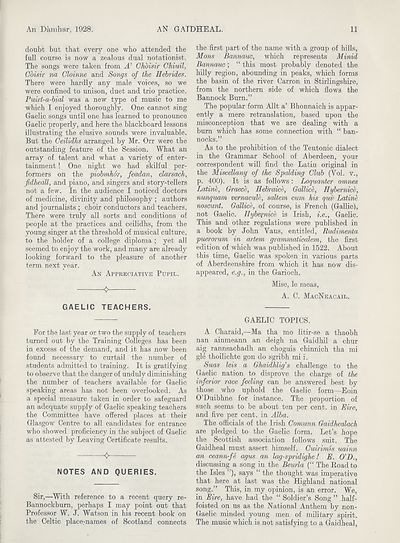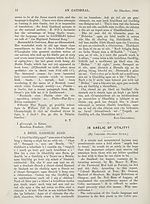An Comunn Gàidhealach Publications > Gaidheal > Volume 24, October 1928--September 1929
(19) Page 11
Download files
Complete book:
Individual page:
Thumbnail gallery: Grid view | List view

An Damhar, 1928.
AN GATDHEAL.
11
doubt but that every one who attended the
full course is now a zealous dual notationist.
The songs were taken from A’ Chbisir Chiuil,
Cbisir na Cloinne and Songs of the Hebrides.
There were hardly any male voices, so we
were confined to unison, duet and trio practice.
Puirt-a-bial was a new type of music to me
which I enjoyed thoroughly. One cannot sing
Gaelic songs until one has learned to pronounce
Gaelic properly, and here the blackboard lessons
illustrating the elusive sounds were invaluable.
But the Ceilidhs arranged by Mr. Orr were the
outstanding feature of the Session. What an
array of talent and what a variety of enter¬
tainment ! One night we had skilful per¬
formers on the piobmhor, feadan, clarsach,
fidheall, and piano, and singers and story-tellers
not a few. In the audience I noticed doctors
of medicine, divinity and philosophy ; authors
and journalists ; choir conductors and teachers.
There were truly all sorts and conditions of
people at the practices and ceilidhs, from the
young singer at the threshold of musical culture,
to the holder of a college diploma ; yet all
seemed to enjoy the work, and many are already
looking forward to the pleasure of another
term next year.
An Appreciative Pupil.
❖
GAELIC TEACHERS.
For the last year or two the supply of teachers
turned out by the Training Colleges has been
in excess of the demand, and it has now been
found necessary to curtail the number of
students admitted to training. It is gratifying
to observe that the danger of unduly diminishing
the number of teachers available for Gaelic
speaking areas has not been overlooked. As
a special measure taken in order to safeguard
an adequate supply of Gaelic speaking teachers
the Committee have offered places at their
Glasgow Centre to all candidates for entrance
who showed proficiency in the subject of Gaelic
as attested by Leaving Certificate results.
NOTES AND QUERIES.
Sir,—With reference to a recent query re-
Bannockburn, perhaps I may point out that
Professor W. J. Watson in his recent book on
the Celtic placernames of Scotland connects
the first part of the name with a group of hills,
Mans Bannauc, which represents Minid
Bannauc; “ this most probably denoted the
hilly region, abounding in peaks, which forms
the basin of the river Carron in Stirlingshire,
from the northern side of which flows the
Bannock Burn.”
The popular form Allt a’ Bhonnaich is appar¬
ently a mere retranslation, based upon the
misconception that we are dealing with a
burn which has some connection with “ ban¬
nocks.”
As to the prohibition of the Teutonic dialect
in the Grammar School of Aberdeen, your
correspondent will find the Latin original in
the Miscellany of the Spalding Club (Yol. v.,
p. 400). It is as follows: Loquunter omnes
Latine, Graece, Hebraice, Gallice, Hybernice,
nunquam vernacule, saltern cum his quv Latine
noscunt. Gallice, of course, is French (Gallic),
not Gaelic. Hybexnick is Irish, i.e., Gaelic.
This and other regulations were published in
a book by John Vaus, entitled, Rvdimenta
puerorum in artem grammaticalem, the first
edition of which was published in 1522. About
this time, Gaelic was spoken in various parts
of Aberdeenshire from which it has now dis¬
appeared, e.g., in the Garioch.
Mise, le meas,
A. C. MacNeacail.
GAELIC TOPICS.
A Charaid,—Ma tha mo litir-se a thaobh
nan ainmeann an deigh na Gaidhil a chur
aig rannsachadh an choguis chinnich tha mi
gle thoilichte gon do sgribh mi i.
Suas leis a Ghaidhlig’s challenge to the
Gaelic nation to disprove the charge of the
inferior race feeling can be answered best by
those who uphold the Gaelic form—Eoin
O’Duibhne for instance. The proportion of
such seems to be about ten per cent, in Eire,
and five per cent, in Alba.
The officials of the Irish Comunn Gaidhealach
are pledged to the Gaelic form. Let’s hope
the Scottish association follows suit. The
Gaidheal must assert himself. Cuirimts uainn
an ceann-fe agus an lag-spridighe! E. O’D.,
discussing a song in the Beurla (“ The Road to
the Isles ”), says “ the thought was imperative
that here at last was the Highland national
song.” This, in my opinion, is an error. We,
in Eire, have had the “ Soldier’s Song ” half-
foisted on us as the National Anthem by non-
Gaelic minded young men of military spirit.
The music which is not satisfying to a Gaidheal,
AN GATDHEAL.
11
doubt but that every one who attended the
full course is now a zealous dual notationist.
The songs were taken from A’ Chbisir Chiuil,
Cbisir na Cloinne and Songs of the Hebrides.
There were hardly any male voices, so we
were confined to unison, duet and trio practice.
Puirt-a-bial was a new type of music to me
which I enjoyed thoroughly. One cannot sing
Gaelic songs until one has learned to pronounce
Gaelic properly, and here the blackboard lessons
illustrating the elusive sounds were invaluable.
But the Ceilidhs arranged by Mr. Orr were the
outstanding feature of the Session. What an
array of talent and what a variety of enter¬
tainment ! One night we had skilful per¬
formers on the piobmhor, feadan, clarsach,
fidheall, and piano, and singers and story-tellers
not a few. In the audience I noticed doctors
of medicine, divinity and philosophy ; authors
and journalists ; choir conductors and teachers.
There were truly all sorts and conditions of
people at the practices and ceilidhs, from the
young singer at the threshold of musical culture,
to the holder of a college diploma ; yet all
seemed to enjoy the work, and many are already
looking forward to the pleasure of another
term next year.
An Appreciative Pupil.
❖
GAELIC TEACHERS.
For the last year or two the supply of teachers
turned out by the Training Colleges has been
in excess of the demand, and it has now been
found necessary to curtail the number of
students admitted to training. It is gratifying
to observe that the danger of unduly diminishing
the number of teachers available for Gaelic
speaking areas has not been overlooked. As
a special measure taken in order to safeguard
an adequate supply of Gaelic speaking teachers
the Committee have offered places at their
Glasgow Centre to all candidates for entrance
who showed proficiency in the subject of Gaelic
as attested by Leaving Certificate results.
NOTES AND QUERIES.
Sir,—With reference to a recent query re-
Bannockburn, perhaps I may point out that
Professor W. J. Watson in his recent book on
the Celtic placernames of Scotland connects
the first part of the name with a group of hills,
Mans Bannauc, which represents Minid
Bannauc; “ this most probably denoted the
hilly region, abounding in peaks, which forms
the basin of the river Carron in Stirlingshire,
from the northern side of which flows the
Bannock Burn.”
The popular form Allt a’ Bhonnaich is appar¬
ently a mere retranslation, based upon the
misconception that we are dealing with a
burn which has some connection with “ ban¬
nocks.”
As to the prohibition of the Teutonic dialect
in the Grammar School of Aberdeen, your
correspondent will find the Latin original in
the Miscellany of the Spalding Club (Yol. v.,
p. 400). It is as follows: Loquunter omnes
Latine, Graece, Hebraice, Gallice, Hybernice,
nunquam vernacule, saltern cum his quv Latine
noscunt. Gallice, of course, is French (Gallic),
not Gaelic. Hybexnick is Irish, i.e., Gaelic.
This and other regulations were published in
a book by John Vaus, entitled, Rvdimenta
puerorum in artem grammaticalem, the first
edition of which was published in 1522. About
this time, Gaelic was spoken in various parts
of Aberdeenshire from which it has now dis¬
appeared, e.g., in the Garioch.
Mise, le meas,
A. C. MacNeacail.
GAELIC TOPICS.
A Charaid,—Ma tha mo litir-se a thaobh
nan ainmeann an deigh na Gaidhil a chur
aig rannsachadh an choguis chinnich tha mi
gle thoilichte gon do sgribh mi i.
Suas leis a Ghaidhlig’s challenge to the
Gaelic nation to disprove the charge of the
inferior race feeling can be answered best by
those who uphold the Gaelic form—Eoin
O’Duibhne for instance. The proportion of
such seems to be about ten per cent, in Eire,
and five per cent, in Alba.
The officials of the Irish Comunn Gaidhealach
are pledged to the Gaelic form. Let’s hope
the Scottish association follows suit. The
Gaidheal must assert himself. Cuirimts uainn
an ceann-fe agus an lag-spridighe! E. O’D.,
discussing a song in the Beurla (“ The Road to
the Isles ”), says “ the thought was imperative
that here at last was the Highland national
song.” This, in my opinion, is an error. We,
in Eire, have had the “ Soldier’s Song ” half-
foisted on us as the National Anthem by non-
Gaelic minded young men of military spirit.
The music which is not satisfying to a Gaidheal,
Set display mode to:
![]() Universal Viewer |
Universal Viewer | ![]() Mirador |
Large image | Transcription
Mirador |
Large image | Transcription
| An Comunn Gàidhealach > An Comunn Gàidhealach Publications > Gaidheal > Volume 24, October 1928--September 1929 > (19) Page 11 |
|---|
| Permanent URL | https://digital.nls.uk/125294724 |
|---|
| Description | This contains items published by An Comunn, which are not specifically Mòd-related. It includes journals, annual reports and corporate documents, policy statements, educational resources and published plays and literature. It is arranged alphabetically by title. |
|---|
| Description | A collection of over 400 items published by An Comunn Gàidhealach, the organisation which promotes Gaelic language and culture and organises the Royal National Mòd. Dating from 1891 up to the present day, the collection includes journals and newspapers, annual reports, educational materials, national Mòd programmes, published Mòd literature and music. |
|---|---|
| Additional NLS resources: |
|

